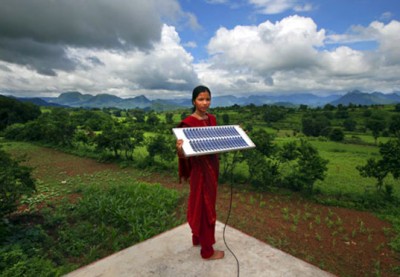The price of solar in India could fall below that of coal within 5 years

By Dr Anthony Horton
According to a KPMG report published this month, the price of solar power has declined more than that expected by many analysts since January this year. In India currently, the price of solar is within 15% of coal process on a levelised basis. In the report titled “The Rising Sun-Disruption of the horizon”, KPMG contends that while the current price of solar doesn’t include grid integration costs, even after taking them into consideration, solar would still be competitive with coal. By 2020, they forecast that the price of solar power could be approximately 10% less than that of coal.
By 2020, KPMG forecasts a generation price of INR 4.2/kWh and INR 3.59 kWh by 2025 (at today’s prices), and that wind and solar generation could constitute 20% of India’s energy supply mix by 2025. The biggest potential factor in solar power pricing in India could be rooftop solar, especially if it is supported by the continuing evolution of storage technologies. KPMG predicts that rooftop solar could provide 10 GW within 5 years and 49 GW within 10 years, and could mitigate as much as 275 million tonnes of carbon emissions in 2025. Thus it would make a sizeable contribution to India’s INDC which included a 33-35% reduction in emissions intensity of its GDP by 2030 from 2005 levels.
In addition to price forecasts, the KPMG report pointed to the need for stakeholders to understand the possible extent of the impact of falling solar prices on the coal industry, and to the need to face it. A new planning paradigm that takes into account a significant renewable energy input scenario (including storage and smart grids) going forward was needed in India, and the report also suggested that the Government focus on bolstering planning policy, institutions, resources and protocols. Appropriate incentives for investment in the integration of solar into the grid and balancing services should be implemented early, and consideration should be given to storage technologies being promoted in a similar fashion to the way solar power was encouraged through the National Solar Mission in 2009.
In flagging the significant competition utilities are likely to face from distributed rooftop solar, KPMG suggests they get into rooftop solar themselves and develop new revenue models based on the relationships they have with existing customers. If they don’t confront the competition, they could face losing customers and may need to rely on subsidies to remain solvent. They will also need to examine their power procurement portfolio and look at how they contract incremental capacities. The cost structures of new capacities should be scrutinised closely prior to committing.
On the basis that solar power in India would be at a sufficient scale from 2022, the coal sector would come under pressure. To meet that challenge, the sector should focus on cost efficiency and flexibility, according to KPMG. Imported coal prices could be influenced by a number of factors including slowing growth in China, energy efficiency (on the demand side) and a fall in the commodities cycle. KPMG further recommended that Coal India Limited conduct a study of long run costs and add flexibility to its operations so it can adjust to different demand and price scenarios as they arise.
A framework for encouraging private investment in ancillary services needs to be urgently addressed, according to KPMGs report. The solar sector represents significant investment opportunities, including storage solutions, demand response and grid balancing, however the significant ramp up needs are such that the availability of sufficient domestic capital may represent a challenge. International funds and domestic bond markets should be investigated by investors, according to KPMG. Given that solar is approximately four times as capital intensive as coal on a per kWh basis, a global economic recession could have a potentially significant impact-not just in terms of the availability of capital but also in terms of falling fossil fuel prices which would make solar potentially less attractive. If shale gas or clean coal technologies become more prominent they could also pose a threat.
In KPMGs opinion, solar power has the potential to be a significant part of India’s energy mix in the next decade. Solar is clean and will reduce coal consumption over time, which will help India’s fight against climate change. Rooftop solar can take the pressure off distribution grids, which are of lower quality especially in rural areas according to KPMG. The continued evolution of storage technologies could lead to further development of electric vehicles in India, which in turn would reduce oil consumption and could possibly increase energy self-reliance. From a global point of view, reduced oil consumption and storage technologies offer the potential for increased energy security which is critical for every nation.
 About the author: Anthony Horton holds a PhD in Environmental Science, a Bachelor of Environmental Science with Honours and a Diploma of Carbon Management. He has a track record of delivering customised solutions in Academia, Government, the Mining Industry and Consulting based on the latest wisdom and his scientific background and experience in Climate/Atmospheric Science and Air Quality. Anthony’s work has been published in internationally recognised scientific journals and presented at international and national conferences, and he is currently on the Editorial Board of the Journal Nature Environment and Pollution Technology. Anthony also blogs on his own site, The Climate Change Guy.
About the author: Anthony Horton holds a PhD in Environmental Science, a Bachelor of Environmental Science with Honours and a Diploma of Carbon Management. He has a track record of delivering customised solutions in Academia, Government, the Mining Industry and Consulting based on the latest wisdom and his scientific background and experience in Climate/Atmospheric Science and Air Quality. Anthony’s work has been published in internationally recognised scientific journals and presented at international and national conferences, and he is currently on the Editorial Board of the Journal Nature Environment and Pollution Technology. Anthony also blogs on his own site, The Climate Change Guy.
Like what we do at The AIMN?
You’ll like it even more knowing that your donation will help us to keep up the good fight.
Chuck in a few bucks and see just how far it goes!
Your contribution to help with the running costs of this site will be gratefully accepted.
You can donate through PayPal or credit card via the button below, or donate via bank transfer: BSB: 062500; A/c no: 10495969









